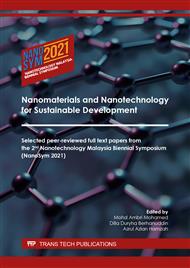p.13
p.19
p.27
p.37
p.47
p.53
p.63
p.69
p.77
Utilizing Sulfonated Reduced Graphene Oxide as a Dopant to Enhance Perovskite Grain Sizes
Abstract:
Out of the perovskite material used in Perovskite Solar Cells, methylammonium lead triiodide (MAPbI3) is the most studied, proving to yield a device with high power conversion efficiency. However, this perovskite material has a high tendency to degrade, especially when exposed to high humidity and ambient atmosphere. The degradation issue has led to its poor morphology, which eventually affects the device's power conversion efficiency based on this perovskite material. Therefore, this study aims to enhance the morphological property of the perovskite thin film by incorporating sulfonated reduced graphene oxide (srGO) as a dopant. The reduced graphene oxide is synthesized through modified Hummer's method and further sulfonated before being incorporated into the perovskite thin film deposited under relative humidity above 80% in ambient conditions. The srGO has successfully assisted the nucleation growth of MAPbI3 with the increment of grain size is approaching micron-sized. In this work, the optimized weight percentage of srGO in methylammonium iodide (MAI) precursor is found to be 20% resulting in grain size in the diameter range of 300 to 1000 nm. Hence, this perovskite doped srGO would be incorporated as the active layer for further application, especially in inverted planar perovskite solar cells.
Info:
Periodical:
Pages:
47-51
Citation:
Online since:
March 2022
Keywords:
Price:
Сopyright:
© 2022 Trans Tech Publications Ltd. All Rights Reserved
Share:
Citation:


